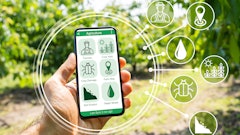
Evolving consumer tastes and demand have foodservice companies re-evaluating their supply chain practices. The way consumer eating habits have changed means there are a variety of ways end customers receive their food and beverage products.
Americans are dining out less, and while a portion of personal food and beverage purchasing still takes place at traditional supermarkets, one-stop shopping has become less common with the growth of specialty brick-and-mortar stores, on-demand grocery ordering, and other online delivery options. These online alternatives include the assemble-at-home meal kits, whose growing popularity and convenience has created another set of logistics operations altogether.
Additionally, social changes mean consumers are more aware of sustainable sourcing strategies and want to know where exactly their food is coming from and the circumstances of its journey. That means there’s increasing demand for free-range chicken, grass-fed beef, and organic fruits and vegetables.
The fact is, diversified consumer demand isn’t growing the overall food pie, but is only further dividing the food and beverage spend. With the spend spreading out, how can foodservice organizations ensure their products stay relevant and in demand? And what does this mean for food logistics companies?
The Supply Chain Efficiency Quest
In short, food service organizations must get smarter and more efficient, and they must squeeze every drop of value from their supply chain to ensure consistent quality and supply of ingredients, access to their products, and competitive margins. The onus will fall heavily on the logistics side of the house, and that’s why technology must continue to drive supply chain modernization.
Keeping with the pie analogy, food logistics organizations must provide more slices of the same service pie to support its customers and grow the business. With an increased number of trading partners and data flows, more cloud-based and on-premise platforms to connect to, and additional ways of exchanging information, all of which require elevated security and transparency, the complex mesh of systems and applications to support these emerging needs can become unwieldy.
The critical requirement for logistics organizations, then, is maintaining a real-time view of the holistic supply chain that connects restaurants, retailers and other vendors with the entire ecosystem. However, that’s a tall ordering considering the sheer number of people, applications and systems that touch and act on the purchase orders, invoices, shipping notices, trucking logs, financial info and other critical data powering the operation.
That’s where complete and flexible B2B integration comes to play. An interoperable platform integrates the core EDI, MFT, WMS and TMS solutions managing these data sets; supports APIs, mobile and emerging IoT-like tracking devices; and connects the supply chain like never before.
This single, elastic, highly available event-driven platform, one that’s independent of batch processing and programming to monitor folders, powers the modern supply chain. Savvy organizations deploy such flexible B2B integration technologies to attain a well-orchestrated way to hand customer and partner data off to a reliable transport mechanism, into a robust transformation engine, and into back-end applications in real time.
Thus, every player in the supply chain—growers and suppliers, warehouses, distribution centers, retailers, logistics organizations—will be digitally connected, enabling companies to better:
- Take and fulfill orders,
- Coordinate supply and delivery,
- Monitor inventory, and
- Forecast demand.
Now more than ever food logistics organizations have the proper tools to enhance visibility, reduce inefficiencies, and ensure timely fulfillment to meet the needs of the ever-evolving food service industry.
Consumer, Business Flexibility
Consumers likely will never understand how their shifting tastes affect the food supply chain, but it’s the food logistics organizations, with the modern integration technology to keep up, who actually afford consumers the flexibility to consume as they please.
A flexible platform that manages inbound and outbound EDI and fully integrates with your ERP and other applications delivers a seamless flow of information that supports new business and mitigates risk. But many food distributors realize extensive time and cost savings with advanced B2B integration technology that also supports non-EDI workflows.
“A flexible B2B integration platform is like having a thousand different languages in our back pocket to communicate with anybody,” says Michael Hegarty, director of ERP and CRM corporate strategy at Lipari Foods, a Michigan-based food distribution company. “A lot can go wrong when processing order types, but B2B integration makes it easy to take and consume all internal and partner data, and ensures the end customer gets the product when and how they expect it.”
While the foodservice industry may never be able to fully predict every consumer eating and shopping behavior to come, it can quickly adapt to serve them with a technology-driven and connected supply chain.




























